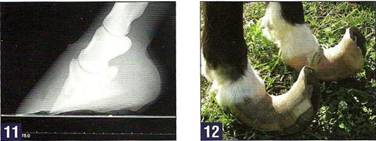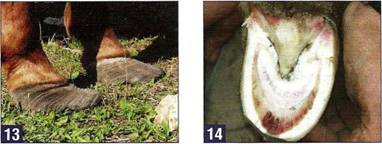Horses With Abscesses Due to Founder
Abscesses Due to Founder – A Painful Condition
The Outlaw Pad treats both laminitis and founder. It was designed as an aid in controlling pain associated with the onset of laminitis and founder in horses. The can be used instead of foam blocks or diapers and other forms of padding. It is made of soft yet strong PVC designed for the horses hoof. The Outlaw Pad has been patented for the relief of pain that comes along with laminitis and founder. The Outlaw Pad was designed as an open toe shoe to release the pressure off the point of the coffin bone in the hoof capsule. As the coffin bone destabilize and sinks the sole is trapped between the coffin bone and the ground, bedding, foam brick pad or any other packing applied to the sole. This pinching of the sole causes bruising and abscessing in the already compromised tissue of the sole.
The Outlaw shoe is designed as an aid in preventing abscesses and help with pain associated with this process. By opening the toe and stopping the pressure on the sole and coronary band it will increase blood flow across the front opening the circumflex artery. As the blood pressure decreases in the hoof capsule the digital pulse will decrease in turn along with pain. Use of the Outlaw shoe will increase the horse’s chance of a better recovery.
Understanding the Difference of Laminitis and Founder
It is important to understand the difference between the terms laminitis and founder, even though the two terms are used by most as if they mean the same thing.
Laminitis is the first to happen and is in the foot, it means inflammation of the sensitive laminae. When a horse is suffering from laminitis it has an inflammation of the laminae that is between the hoof wall and the coffin bone. This can and leads to the next step called founder.
Founder is after the inflammation has occurred in the laminae. The bone rotates into the sole or the hoof pulls up it really doesn’t matter all that is important is the bone pushes in the sole. If it only pushed into the sole the horse would not develop an abscess but the ground, bedding, sand, rocks, and closed toe shoes all push back on the sole it is the squeezing or pinching of the sole between the bone and the any pressures pushing back. First causing bruising then abscesses in the sole.
This localized pressure band can and dose led to abscesses. A horse’s immune system will often react to the infection by producing pus. Because a hoof is so hard and cannot expand, the pressure caused by the pus will collect in the hoof and cause a significant amount of pain to the animal. Abscesses are generally found in the sole of the hoof but can develop in other places as well. Like the coronary band the rotation of the coffin bone can and dose pinch the tissue at this juncture and can abscesses. A horse that shows severe lameness and pain or that refuses to walk in a particular way may have developed a hoof abscess not all abscess are due to laminitis or founder.
If you have a horse with compromised feet (previous rotation of the coffin bone, medial or lateral rotation of the coffin bone or a sinker) by dropping the heels during trimming it will shift the bone into the sole at the quarters causing bruising and possible abscesses. The guidance of an x-ray would be the best way to proceed. With out an x-ray of the foot let the external signs led you through the trim. Is there old sheering of the laminae at the toe is there bruising in the quarters are the heels crushed is there distorted rings in the hoof showing long term episodes of laminitis.
A swollen leg or fever in the limb can be signs of an abscess. A horse’s leg tendons can also become swollen and painful. If an abscess is left untreated, accumulation of the purulent fluid, or pus, may eventually build up enough pressure to pop out of the heel or coronary band or drain out of the sole. There are a variety of causes that may be responsible for a horse developing a hoof abscess, and founder may be one of the most common. Founder is a very painful condition that can cause a horse to be unable to walk or stand.
Typically starting out as laminitis, founder can actually cause the coffin bone to rotate and penetrate through the soul of the horse’s foot. The pain and stress associated with this condition can cause a horse to spend much of its time lying down or trying to transfer much of its weight to its back feet since the condition often affects the front two feet. The acute Outlaw shoe can and does help with pain and supports the transfer of weight to the heels. Any owner that recognizes that his or her horse is behaving unusually or showing signs of pain or distress should immediately consult with a veterinarian in order to begin the process of treating the condition.
Abscesses Due to Founder
Abscesses due to founder will generally mean that a horse has been in some amount of pain for a period of time. Regularly inspecting a horse’s hooves and providing the animal a clean and dry place to spend its time can help an owner to detect this condition earlier as well as preventing other common ailments associated with these fine animals. A horse’s hooves and shoes should be kept clean and dry and inspected for cracks or other irregularities on a regular basis. The horse should also be provided with a well-balanced and nutritious source of food so that it does not develop an insulin resistance which can lead to laminitis and founder. The Outlaw shoe is a patented pad/shoe for the treatment of laminitis and founder. It is also used by many veterinarians to treat abscesses as they can rap the foot with access to the sole for drainage or packing with medications.




